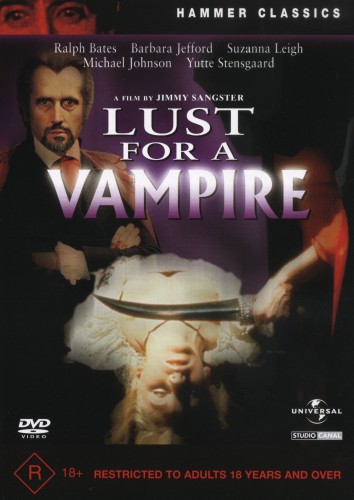Lust for a Vampire (1971) |
|
Lust for a Vampire (1971) |
|


|
| BUY IT |
| General | Extras | ||
| Category | Horror |
Main Menu Audio Theatrical Trailer |
|
| Rating |

|
||
| Year Of Production | 1971 | ||
| Running Time | 91:25 | ||
| RSDL / Flipper | No/No | Cast & Crew | |
| Start Up | Menu | ||
| Region Coding | 4 | Directed By | Jimmy Sangster |
|
Studio
Distributor |
 Universal Pictures Home Video |
Starring |
Ralph Bates Barbara Jefford Suzanna Leigh Michael Johnson Yutte Stensgaard Helen Christie Pippa Steel David Healy Harvey Hall Mike Raven Michael Brennan Jack Melford Christopher Cunningham |
| Case | ? | ||
| RPI | $19.95 | Music | Harry Robinson |
| Video | Audio | ||
| Pan & Scan/Full Frame | None | English Dolby Digital 2.0 (192Kb/s) | |
| Widescreen Aspect Ratio | 1.78:1 | ||
| 16x9 Enhancement |
 |
||
| Video Format | 576i (PAL) | ||
| Original Aspect Ratio | 1.85:1 | Miscellaneous | |
| Jacket Pictures | No | ||
| Subtitles | None | Smoking | No |
| Annoying Product Placement | No | ||
| Action In or After Credits | No | ||
Somewhere near Vienna, 1830. A young woman walking through the forest is lured into a coach. Rendered unconscious, she is taken to a deserted castle, where her blood is used to revivify the rotted corpse of Carmilla Karnstein. Roll credits.
A young English aristocrat, Richard Lestrange (Michael Johnson) is warned by a local innkeeper about the evil Karnstein family. Undeterred, he wanders into the disused Karnstein castle where he is accosted by several young women, who turn out not to be vampires but students at the nearby school for girls. The school is full of nubile young ladies in diaphanous dresses (naturally).
Lestrange is love-struck when he sees the new student, Mircalla, arrive. He conspires to get a temporary job teaching at the school. Pretty soon, Mircalla is demonstrating her fang work amongst the students and faculty.
Lust For a Vampire is a sequel to the superior The Vampire Lovers, released in 1970. In fact, Lust started pre-production while The Vampire Lovers was still shooting. Hammer were sure that they had a successful formula with the lesbian vampire genre, so they rushed through this film to capitalise on the expected success of the first film. Both films are based on the novella Carmilla by the 19th century Irish writer Joseph Sheridan Le Fanu.
The film does not succeed as a horror picture mainly because there is nothing at all scary about it. It does not really succeed at any level, with a poor script by Tudor Gates, average direction by Jimmy Sangster (witness the zoom shot at 76:13, which had me laughing out loud), and some poor performances. Mircalla is played by the lovely Yutte Stensgaard, who expresses her emotions by slightly crossing and uncrossing her eyes. Michael Johnson is adequate as Lestrange. Count Karnstein is played by Mike Raven, a disc jockey cast for his obvious resemblance to Christopher Lee, who had the good sense not to be involved. Raven seems to be dubbed by an actor with a deep voice like Lee's, and a close-up of the Count's eyes is actually footage of Lee from another film. Terence Fisher was originally scheduled to direct, but broke his leg a few days before the start of filming.
The role of the teacher Giles Barton is played (badly) by Ralph Bates, who was brought in at the last minute to replace Peter Cushing, whose wife was ill, and he gets top billing in this film. Bates, a great-great-nephew of Louis Pasteur, had been groomed by Hammer to be their next Dracula, but he ended up playing leading parts in a variety of horror roles instead. His acting is quite hammy and mannered in this film, as if he was trying out for the part of Renfield in the next remake of Dracula. Bates himself thought that this was the worst film ever made.
There is a surprisingly small amount of nudity in this film, and all of it is in context and is included for purely artistic reasons... of the totally gratuitous kind.
The film is presented in an aspect ratio of 1.78:1 and is enhanced for 16x9 displays. The original aspect ratio was 1.85:1.
The transfer is pretty sharp throughout. The image is bright and generally quite clear, with night scenes being filmed during the daytime. There is no problem with shadow detail, although the photography is quite slipshod. An example of this is at 71:10 when Mircalla tries to lure Janet Playfair into her room. Both actresses disappear murkily into a dark spot in the lighting, something which looks amateurish in a commercial feature film.
The transfer looks all right at first, but after a few minutes it becomes grainy, rather too much so for my taste. Much of the film has a veil of grain, more than you would expect from film grain. This for me was the most disappointing aspect of the transfer.
Film artefacts were limited to minor white spots and dirt, which appear throughout much as they would on a theatrical print, though the absence of reel change markings suggests that this print was not such a print. It is a pity that this was not cleaned up, but the damage is very minor and would not be intrusive to most viewers. There is also a brief scratch mark visible at 17:38.
The disc has a single-layer and there are no subtitles.
| Sharpness | |
| Shadow Detail | |
| Colour | |
| Grain/Pixelization | |
| Film-To-Video Artefacts | |
| Film Artefacts | |
| Overall |
The usual English Dolby Digital 2.0 transfer is here in glorious mono sound. The film was released with a mono soundtrack, so the absence of a surround track is not an issue. Obviously, there is no subwoofer or rear channel usage.
Dialogue is clear and easy to understand.
The music score by Harry Robinson is pretty bad. There is even a terrible song, "Strange Love", which appears a couple of times during the film. This has to be heard to be believed.
| Dialogue | |
| Audio Sync | |
| Clicks/Pops/Dropouts | |
| Surround Channel Use | |
| Subwoofer | |
| Overall |
An original trailer for the film, presented in 1.33:1, which looks like the original aspect ratio. This is quite silly, but it does give an accurate impression of the film.
There is censorship information available for this title. Click here to read it (a new window will open). WARNING: Often these entries contain MAJOR plot spoilers.
NOTE: To view non-R4 releases, your equipment needs to be multi-zone compatible and usually also NTSC compatible.
This has been released in Region 1 by Anchor Bay. In comparison to the Region 1, the Region 4 release misses out on:
In comparison to the Region 4, the Region 1 misses out on:
The Anchor Bay release is (according to the Anchor Bay website) in an aspect ratio of 1.77:1. Apart from that, reviews indicate that the issue with grain found in the Region 4 transfer is not present. Therefore, the Region 1 version must be counted the winner.
While this film is not terrible, don't expect to have sleepless nights after watching it. The transfer has some problems and you might be better advised to seek out the Region 1 disc.
The video quality is slightly below average.
The audio quality is satisfactory.
The single extra is acceptable but pales in comparison to the extras on the Region 1 release.
| Video | |
| Audio | |
| Extras | |
| Plot | |
| Overall |
| Review Equipment | |
| DVD | Pioneer DV-S733A, using Component output |
| Display | Sony 86CM Trinitron Wega KVHR36M31. Calibrated with Ultimate DVD Platinum. This display device is 16x9 capable. |
| Audio Decoder | Built in to DVD player, Dolby Digital, dts and DVD-Audio. Calibrated with Ultimate DVD Platinum. |
| Amplification | Yamaha RX-V596 for surround channels; Yamaha AX-590 as power amp for mains |
| Speakers | Main: Tannoy Revolution R3; Centre: Richter Harlequin; Rear: Pioneer S-R9; Subwoofer: JBL SUB175 |